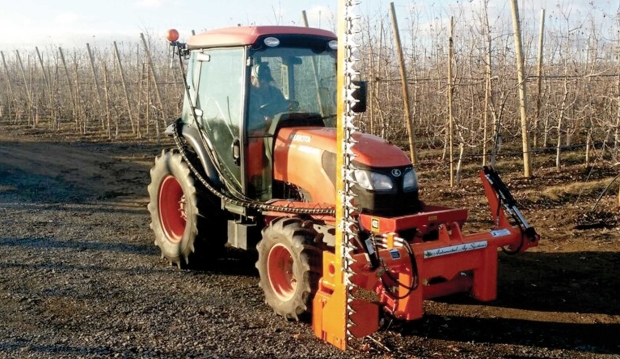
A mechanical hedger can help growers save on labor costs, but the method may also improve fruit quality. (Courtesy Karen Lewis/Washington State University)
Columbia Fruit Packers, based in Wenatchee, is one of several Washington apple producers who are experimenting with mechanical pruning.
Italian horticulturist Dr. Alberto Dorigoni, one of the world’s authorities on mechanical pruning in modern orchard systems, visited the Pacific Northwest this spring to talk about his work.
Dorigoni, who is based at the Institute of Agriculture at San Michele all’Adige in the South Tyrol, said the fruiting wall allows growers to increase economic and ecological sustainability by cutting chemical and labor inputs while maintaining high yields.
In Europe, mechanical pruning or hedging is being used extensively.
Tim Welsh, horticulturist and varieties manager at Columbia Fruit, travels frequently to Europe and said he was motivated to try mechanical pruning after seeing it used in Belgian orchards.
What he liked about the technique was it created a fruiting wall with buds throughout the tree and good light penetration from top to bottom.
“But I was convinced that hedging alone was not the answer for us because what I saw in some orchards was that they were living by hedging alone and there was this quagmire of branches,” he said. “You could see the fruit quality would not be sufficient for us.”
Welsh said mechanical pruning isn’t a stand-alone technique. Because it’s not selective, it makes good and bad cuts. Hand pruning is still needed during the dormant season to remove unwanted wood.
But the hedging does make hand pruning more efficient because workers can more easily select and reach limbs to prune so they can move more quickly in the field. They’re removing limbs, rather than shortening them. He’s heard other growers say that mechanical pruning cut their labor costs for hand pruning by 15 to 25 percent.
But Welsh says reducing pruning costs is not the main reason he’s trying mechanical pruning.
“My primary goal is to create premium fruit,” he said, by which he means fruit with good eating quality, not necessarily higher color.
Columbia Fruit began testing mechanical pruning last summer and bought a hedging machine from a supplier in New York. Welsh said he’s been learning from New York grower Rod Farrow, who had been hedging for several years.
Farrow refers to the fruiting wall canopy as a “box,” by which he means the predetermined area within which the canopy will be maintained.
Hedging is used to eliminate wood that is outside the box. Welsh said he’s adopted that principle because the idea of the box helps pruners to more accurately maintain the narrow canopy within the space.
Most of the plantings Welsh is hedging are trained as narrow slender spindles. Some blocks have multi-leader trees, with anywhere from two to five leaders, with rows 10 feet apart. Others are spaced 2 or 2.5 feet apart on angled trellises with 12 feet between rows.
“Every year, I’m becoming more convinced that the narrower the tree is, with the multi-leader system, the better sunlight penetration I will have and the better fruit quality I will have,” he said. “The caveat is sunburn issues because of our heat, but I’m convinced every year that it’s an easier system. Pruning is so much easier, maintenance is so much easier, and spraying is so much more efficient.”
Welsh said he’s used hedging during the dormant season (January and February) to shape the trees and establish the fruiting wall, but he’s also doing mechanical pruning in early summer in an attempt to stimulate more fruit bud development for the following year.
“The result of that was promising,” he said. “I went out in the field and saw where we had short dard (lateral shoot) development and some—though not all of them—created new fruit buds. So, if you have the right timing, you may have increased fruit set the following season, depending on variety.”
He also is starting to see another benefit, which is the elimination of blind wood in the inner canopy. •






Leave A Comment